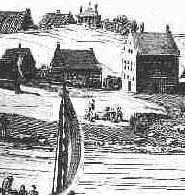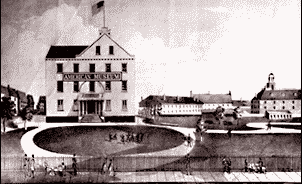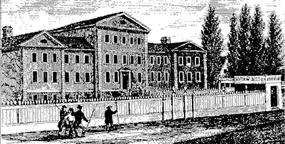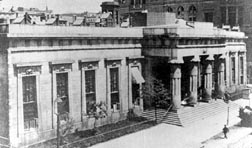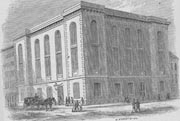| 1625 | Fort Amsterdam is erected with dungeon-like facilities to hold prisoners -- unruly soldiers, uncompliant native people, debtors, disorderly persons and the like. | |
|
1642 |
A three-story stone tavern is built on Dock St. (now Pearl Street) and Coenties Slip. It will eventually serve as tavern, court, city hall and jail. In Dutch, it is called Stats Huys. Its jail, a small room on the first floor rear, is reserved for "civilian" prisoners who become more numerous after incorporation of municipal government in 1653. It was under the command of a Provost Marshal. Governor William Keift had the original tavern built to accommodate visitors who came to town for harvest fairs. |
|
|
1699 |
Stats Huys is condemned as unfit for continued use as a jail/judicial center after having been used that way by both the Dutch and English for more than a half century. It is sold with the proviso that inmates could be kept there up to one month after the sale. |
|
|
1700 |
The new New York City Hall at Wall and Nassau Streets opens as the seat of government, including judicial proceedings for which dangerous prisoners are kept in basement facilities and debtors in the garret. |
|
|
1727 |
Because the New York City Hall basement's security proves inadequate, a watch of four men is appointed to guard the prisoners. Arguably, this may count as the start of an organized force charged with the custody of criminal law prisoners in New York. Old City Hall Park had jails on both side. |
|
|
1759 |
The New Gaol, the first structure built specifically as a jail, is completed on the northeast corner of what is now New York City Hall Park. Most rooms in the three-story structure house civilian lawbreakers. A few rooms are set aside for debtors and paupers. A Keeper of the Gaol is appointed. |
|
|
|
|
|
The State Legislature enacts a law that NYC name at least 12 Commissioners of the Almshouse and Bridewell. Arguably the panel of commissioners is the administrative ancestor of the NYC Dept. of Correction. |
|
|
1797 |
The first New York State prison, built on the bank of the Hudson River at Greenwich Street and Amos Street (now West 10th Street) about a mile and a half from the City Hall Park jails, is ready for occupancy. Opens Nov. 28. A stately structure, the Greenwich State Prison features Doric columns, a cupola, a 14-foot to 23-foot surrounding wall and four acres of grounds. |
|
|
1816 |
New York City's first penitentiary opens on the East River Shore at Bellevue near the Almshouse. Ten years later Bellevue Hospital opens. Bellevue City Penitentiary houses a considerable number of female felons. The New York Society for the Prevention of Pauperism is founded in New York City. |
|
|
1817 |
New York State opens Auburn prison. |
|
|
1820 |
The first case in the history of New York involving a 14-year-old child is heard. |
|
|
1821 |
New York State's Auburn prison opens a "new wing" built in a cell system to replace dormitory housing. An experiment to isolate 80 inmates in the "new wing" fails. Inmates are allowed to leave their cells during the day to work in prison shops. Thus, the "Auburn system" evolves to become the standard for American prisons. |
|
|
1824 |
New York State Legislature incorporates the Society for the Reformation of Juvenile Delinquents as a subsidiary of the New York Society for the Prevention of Pauperism. Authorization given for the construction of a house of refuge for delinquent children. A War of 1812 arsenal was purchased from the City of New York with the condition that its use be devoted to “juvenile offenders.” Located at Broadway and 23rd Street, then a semi-rural environment, the arsenal was rebuilt as a secure residential institution and was known as the New York City House of Refuge. |
|
|
1825 |
The New York City House of Refuge opens on January 1. Ossining prison opens due to overcrowding at Auburn and Newgate. |
|
|
1828 |
The Greenwich State Prison, sometimes called Newgate after the infamous London prison, is sold. The prison structure is destroyed. A prison at Mt. Pleasant that becomes known as Sing Sing is now readied and soon amply able to absorb the inmate population transferred from Greenwich. The NYC Commissioners of the Almshouse and Bridewell purchase Blackwells Island as the site to relocate facilities under their jurisdiction. That includes the NYC Penitentiary. |
|
|
1830 |
The Provost, that had continued at serve as a jail even after the British were defeated and the United States of America emerged as a nation, finally ceases operations as a place of incarceration and is made ready to house the city Register's office. |
|
|
1832 |
The NYC Penitentiary opens on Blackwells Island in the East River. That body of land nearly a century later will be renamed Welfare Island, and several more decades later, Roosevelt Island. The Almshouse Department is created to operate the Almshouse, Bridewell and Penitentiary under five Commissioners. At Auburn, the first state prison matron is hired. |
|
|
1836 |
The cornerstone for the Kings County Jail on Raymond Street is laid. Before Brooklyn becomes part of New York City, and for some time afterwards, the jail operates under the jurisdiction of the Kings County Sheriff. Raymond Street jail. |
|
|
1838 |
The Halls of Justice, four years in the building on the filled-in site of the Collect Pond, is opened on June 18th.
Its damp and dreary cells seem in keeping with the melancholy origin of its design motif -- an Egyptian mausoleum that philanthropist, engineer, world traveler and prison planner John A. Stevens had researched. Thus emerges the name by which a succession of jails on the site will be known despite new designs completely different from the somber original: The Tombs. |
|
|
1839 |
New York State opens Sing Sing prison for women. |
|
|
1845 |
Clinton receives its first state prison inmates to mine and manufacture iron. |
|
|
1847 |
Education programs begin at Sing Sing and Clinton prisons. |
|
|
1848 |
A three-member "Board of Inspectors" is initiated to be in charge of state prisons. |
|
|
1851 |
New York Juvenile Asylum is opened by the Child Savers, a group of reformers that believed city children could be saved if sent to live with farm families. |
|
|
1859 |
New York establishes the nation's first institution for insane criminals on the grounds of Auburn prison. |
|
|
1860 |
Replacing the almshouse agency, the NYC Department of Public Charities and Correction is established to have charge over all the city's public welfare and correctional institutions. |
|
|
1862 |
In June, the New York County Jail opens at Ludlow Street and Essex Market Place. Better known as the Ludlow Street Jail, it is the replacement for the Eldridge Street Jail. |
|
|
1863 |
NYC's Fourth District Prison is built in the Yorkville section of Manhattan. It also becomes known as the 57th Street jail and is part of a court complex. |
|
|
1865 |
NYC's Seventh District Prison is built on the West Side. The “Disorderly Child” Act is passes. This is the first statute permitting the judicial placement of children who had not been criminally convicted. |
|
|
1868 |
NYC purchases Hart Island and gives jurisdiction over it to the Department of Public Charities and Correction. That agency, which already had parts of Ward's Island assigned to it, is given jurisdiction over additional Ward's lands. Corporal punishment is outlawed by the State Legislature. |
|
|
1869 |
In March, one of the Sing Sing prison keepers is killed, Edward Craft. He is believed the first New York correctional officer (prison keeper) known to have been killed in the line of duty. |
|
|
1870 |
The first American Correctional Association Convention is held in Cincinnati. |
|
|
1871 |
Queens County Jail is built in Long Island City. |
|
|
1873 |
The State Legislature mandates New York City to organize the dual Department of Public Charities and Correction into two distinct bureaus: charities and correction. This sets the stage for the later emergence of the bureaus as separate agencies. |
|
|
1875 |
The court/jail complex is enlarged at Jefferson Market, Greenwich Lane and 6th Ave., in Greenwich Village. Later the site will be used for a Women's House of Detention. Also in 1875, the 6th District Prison is added in Fordham. The first Society for the Prevention of Cruelty to Children is established. The confinement of children in almshouses is prohibited. |
|
|
1876 |
Elmira Reformatory opens based on the theory of reform rather than punishment. |
|
1877 |
Act for Protecting Children is enacted in New York State. This is the state’s first generalized neglect statute. The constitutionality of the law is upheld in Matter of Donahue. |
|
|
1878 |
Louis D. Pilsbury becomes the first "Superintendent of Prison" with ultimate responsibility and control of state prisons. |
|
|
1881 |
The House of Refuge for Women is established. The Penal Code is enacted. This codifies and amends children’s laws. |
|
|
1885 |
The city's Fifth District Prison is built at 121st St. and 3rd Ave., East Harlem. The multi-tiers structure features 40 double-occupancy cells and a dormitory that can accommodate another 50 inmates. |
|
|
1884 |
The Department of Public Charities and Correction acquires Rikers Island. |
|
|
1887 |
Inspired by Elmira Reformatory for males, a women's reformatory is opened at Hudson. |
|
|
1890 |
At Auburn prison, William Kemmler becomes the first state inmate electrocuted. |
|
|
1892 |
Statute enacted permitting juvenile case segregation and specialization. |
|
|
1892 |
The Asylum for Insane Convicts is moved from Auburn to Fishkill and becomes known as Matteawan State Hospital for the Criminally Insane. |
|
|
1893 |
The State Use System is established to eliminate profiteering from inmate labor. |
|
|
1893 |
Inspired by Elmira Reformatory for males and the Hudson reformatory for women, another women's reformatory is opened at Albion. |
|
|
1895 |
A new Queens County Jail, consisting of a main building and annex, is erected on Court Square in Long Island City, replacing the one built a quarter century earlier. The new facility eventually becomes known as City Prison of Queens. Its main building features five tiers of cells looking down on a central corridor. Teens get the top tier cells. The jail is designed for 130 double occupancy cells. It remains under the Queens Sheriff until 1912. For a long period the annex will be used as a women's prison. |
|
1895/6 |
The Department of Correction emerges from the division of the dual NYC Department of Public Charities and Correction into separate agencies. The Department of Public Charities will eventually become the Welfare Department. |
